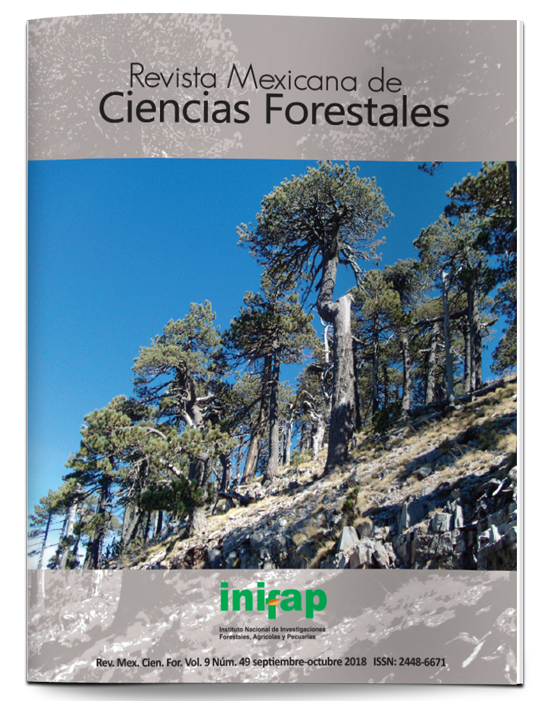Hydroclimatic Behavior of Conifers at Cerro El Potosí, Nuevo León, Mexico
DOI:
https://doi.org/10.29298/rmcf.v9i49.128Keywords:
Conifers, dendrochronology, El Niño Southern Oscillation, atmospheric circulation patterns, hydroclimate, climate variabilityAbstract
Cerro El Potosi (El Potosí Hill) (CPO) has an elevation gradient from 2 200 to 3 719 m and is the habitat of a variety of conifers. The objectives of this study were to 1) integrate a dendrochronological network composed of Pinus culminicola, Pinus hartwegii, Pseudotsuga menziesii, and Pinus greggii; 2) develop a representative rainfall reconstruction, and 3) analyze the influence of atmospheric circulation phenomena on the interannual and multiannual rainfall variability at CPO. In order to fulfill these objectives, four climate-sensitive chronologies were developed, the longest one (1420-2010) being for Pinus hartwegii, and the shortest (1850-2010), for Pinus greggii. The association between chronologies indicates a common climatic signal, as corroborated by the Principal Component Analysis. A representative chronology for different elevations of CPO covering the 1700-2010 period was developed and used to reconstruct the January-September seasonal precipitation. The driest years in the reconstruction were 1785 and 1801, while the wettest years were 1791, 1832, and 1911. The El Niño Southern Oscillation (ENSO) was found to exert a significant influence on rainfall (r= 0.53, p<0.01), through the Tropical Rainfall Index (TRI). The influence of hurricanes detected on the late wood chronologies indicates the potential to analyze the historical impact of this atmospheric disturbance on the production of ecosystem services for the region.
Downloads
Published
How to Cite
Issue
Section
License
The authors who publish in Revista Mexicana de Ciencias Forestales accept the following conditions:
In accordance with copyright laws, Revista Mexicana de Ciencias Forestales recognizes and respects the authors’ moral right and ownership of property rights which will be transferred to the journal for dissemination in open access.
All the texts published by Revista Mexicana de Ciencias Forestales –with no exception– are distributed under a Creative Commons License Attribution-NonCommercial 4.0 International (CC BY-NC 4.0), which allows third parties to use the publication as long as the work’s authorship and its first publication in this journal are mentioned
The author(s) can enter into independent and additional contractual agreements for the nonexclusive distribution of the version of the article published in Revista Mexicana de Ciencias Forestales (for example, include it into an institutional repository or publish it in a book) as long as it is clearly and explicitly indicated that the work was published for the first time in Revista Mexicana de Ciencias Forestales.
For all the above, the authors shall send the form of Letter-transfer of Property Rights for the first publication duly filled in and signed by the author(s). This form must be sent as a PDF file to: ciencia.forestal2@inifap.gob.mx
This work is licensed under a Creative Commons Attribution-Noncommercial 4.0 International license.







